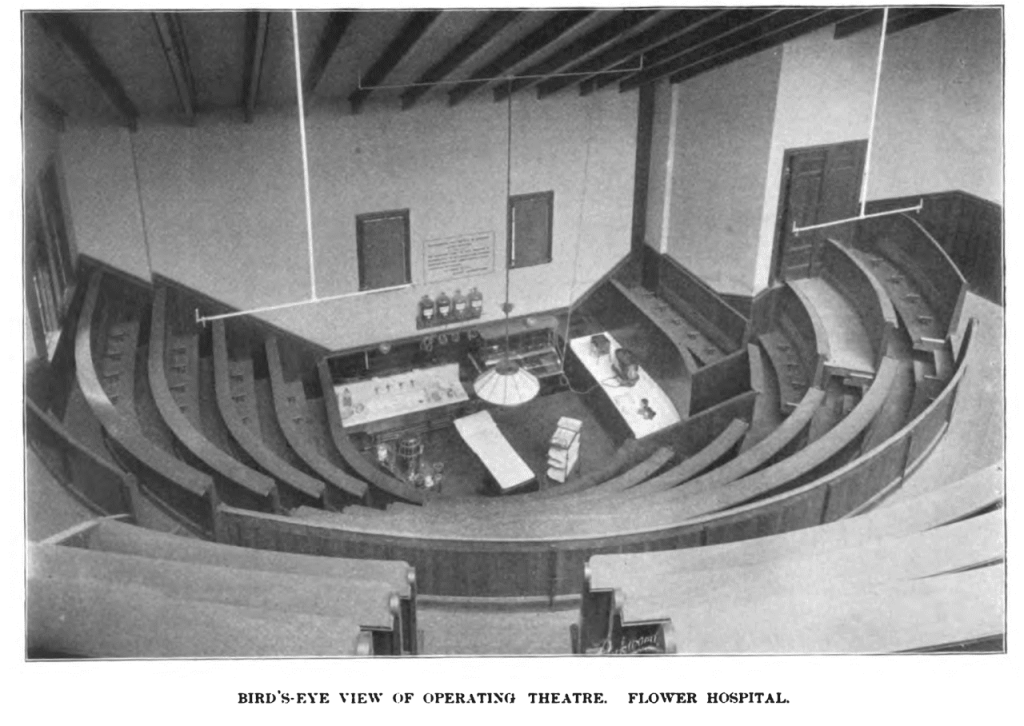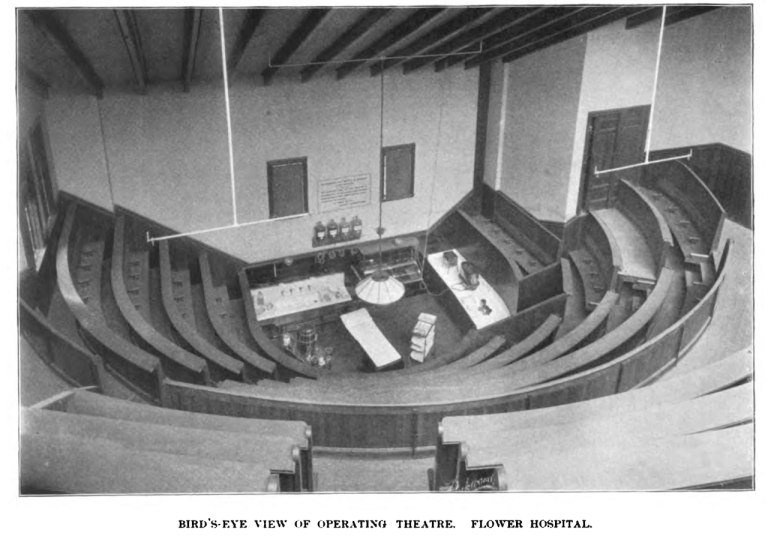Roswell P. Flower Helps To Build Flower Hospital For The Poor Of New York City
One of the many gifts Roswell P. Flower presented to the state of New York was the Flower Hospital, originally known as the Flower Free Surgical Hospital, which was established in 1889. Though his many contributions are well known by those in his native North Country, his philanthropy knew no limits. The hospital was established on New York City’s east side to ensure the many less fortunate received the same quality care as the wealthy.

The Homeopathic School of Physicians in New York City were erecting a college at the time but had no hospital to teach and train their students. When Dr. William Tod Helmuth suggested the Homeopathic Medical College needed a hospital, Mr. Flower reportedly responded, “That is so. It is an excellent idea.”
Roswell P. Flower immediately set to work on having the hospital at Sixty-Third Street and Avenue A, now York Avenue, built under the name of “The Roswell P. Flower Free Surgical Hospital.”
As the Watertown Re-Union reported on May 27, 1896—
Ex-Governor Flower for a number of years has been keenly interested in the Flower Homeopathic Hospital, Sixty-third Street and Avenue A. There are forty-eight beds in the hospital, seven of which have been endowed by Mr. Flower and his relatives. The hospital is situated in one of the busiest centers of New York. It now practically occupies the field so long and efficiently covered by old St. Luke’s. It takes money to run a hospital.
The Post Graduate, the St. John’s Guild, and the Lying-in hospitals all receive from the city $1 per day for all free patients up to $30,000 a year. The Flower hospital is the only homeopathic surgical hospital in that busy section or anywhere near it. So a bill was introduced at Albany and passed allowing New York City to give this important institution $1 a day for free patients up to $12,000 a year. It was a most modest request, in the estimation of those familiar with the work of the hospital.

Even after Roswell P. Flower‘s death in 1899, the Flower family continued to contribute heavily to the work of the hospital. Regarding endowments, Mr. Flower had given the Flower fund $40,000. Other endowments added up to $180,000, which would have proved insufficient for the growing hospital. As the New York Herald noted in January 1900–
The original intention to have simply a surgical hospital was changed when it was found that the poor flocked there in need of medical treatment also. A medical department was built and opened in 1896. The majority of the patients at the hospital are treated free. It was the original intention to have the institution entirely free, but this idea was altered when it was discovered that many persons able to pay were taking advantage of the hospital’s charity.
In 1897 the hospital treated 4,000 patients. Out of 14,054 days’ treatment, 11,635 were free.

Such growth, however, would be matched and surpassed by the continuous generosity of the Flower family, as the Herald continued in its report–
Flower hospital has again been the recipient of the beneficence of the Flower family. At a meeting of the board of trustees of the hospital, held last Tuesday night at the Manhattan hotel, Mrs. Roswell P. Flower presented $100,000 to the hospital and Mrs. Emma Flower Taylor, the daughter of Roswell P. Flower, also gave the institution $100,000.
The only condition attached to the gifts was the name “Flower Hospital” shall be retained in perpetuity.

In 1901, Roswell P. Flower’s only surviving brother, Anson R. Flower, presented to the Flower Hospital $24,000 to purchase adjoining property for expansion with hopes it would suffice for several years. By the end of the year, it was already full. Many of the additional funds received were by subscriptions that came from prominent Jefferson County residents in support of the hospital, many of which may be familiar to Northern New Yorkers, via December 14, 1901, Watertown Daily Times:
Fred S. Flower
Mr. and Mrs. F. R. Halsey
N. M. Flower
Mr. and Mrs. B. L. Taylor
Mr. and Mrs. H. E. Smith
Mr. and Mrs. Norris Mundy
Mr. and Mrs. L. O. Woodruff
Mr. and Mrs. I. A. Kipp
Mrs. Mary E. Flower
Mr. and Mrs. John S. George
Mr. and Mrs. N. M. George
Mr. and Mrs. S. L. George
Mrs. R. S. Hungerford
Mr. and Mrs. O. E. Hungerford
Mrs. John D. Flower
Hon. Allen C. Beach
Mr. and Mrs. Andrew Irving
Mrs. May Robinson
H. H. Porter
Henry Siebert
L. B. Flower
W. B. Lockwood
H. S. Kearney
B. C. Vandyke
Henry Folger
George B. Phelps
Harrison Fuller

That December 14th of 1901, it would be written in the Watertown Daily Times–
New York, Dec. 10 – No person can plan or conceive a more beautiful charity than the Flower Hospital in this city.
Indeed, it is a question whether there is another institution in any city in the world that equals this in its painstaking and earnest efforts to relieve the sufferings of the poor and unfortunate. And it is all free, no charge of any kind or nature being made. Furthermore, it is the aim here to treat the poorest patient just as well as the rich are treated elsewhere.
The group of substantial buildings, known as the Flower Hospital, is located on high and commanding ground at the corner of Sixty-third Street and Eastern Boulevard, within a stone’s throw of the East River. A more admirable site for an institution of this character could not have been chosen, and it reflects the wisdom of the noble-hearted man whose name it bears.
Long live the Flower hospital, and may none of its many kind friends ever know the keen pangs of want and woe.

That would not be the end of the contributions. In 1907, Anson Flower and Emma Flower Taylor would again would offer $200,000 worth of two new buildings, the one from Emma being a nurses’ home and Anson’s a dispensary with apartments for physicians and surgeons.
The contributions of the Flower family not only helped the poor of New York City to receive medical treatment, but they also helped many people of Watertown over the years pursue careers in nursing and administration. Countless people would venture to New York City to study at the college, no doubt because of their unique position of having a hometown connection to its namesake – and the pipeline flowed both ways as Watertown would become the recipient of Doctors and nurses who were graduates of the New York Homeopathic College and Flower Hospital.

In 1935, the Flower Hospital would transfer outpatient activities to what was referred to as the Flower-Fifth Ave Hospital, merging with Hahnemann Hospital and Laura Franklin (Delano) Free Hospital for Children, located at Fifth Ave and between East 105th and East 106th streets in Manhattan.
In 1971, New York Medical College started moving its operations to the suburbs. Seven years later, the Flower Hospital would become affiliated with and owned by the Archdiocese of New York, which helped the hospital to maintain financial stability, largely due to the efforts of Archbishop Terence Cardinal Cooke.
Six years later, after the Archbishop’s passing, the hospital, which had mainly converted to a long-term residential care and short-term rehabilitation facility, would honor the former Archbishop by renaming it the “Terrance Cardinal Cooke Health Care Center,” which it remains today.
















